By Mike Tanner, Photos By Steve Dandy
HARBINGER, NC -- According to the printed card displayed on the front of my golf cart, I was about to "Play the Legend." Quite the boast for a course that opened less than a year ago, in the fall of 2002.
But as I found out over the next few hours, Kilmarlic Golf Club, in Harbinger, North Carolina doesn't need to rely on the past to provide present-day guests with a memorable round of golf.
Kilmarlic is just five miles west of the bridge that connects the mainland to the Outer Banks. For vacationing golfers staying on the beach side of the bridge, Kilmarlic is easily within reach.
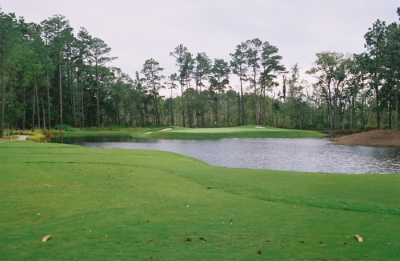 |
| Kilmarlic's relatively short par three 11th features an island green. |
What may seem farfetched is the course's name. Bryan Sullivan, Director of Golf at Kilmarlic and its sister course, Seascape Golf Links, explained it like this:
"A history book about Currituck County mentions an area known as Kilmarlic. One story of how that came about is what we chose as the legend. In the 1700s a ship sailed out of Kilmarnock, Scotland laden with casks of whisky and ran aground on the nearby Carolina coast. The locals who salvaged the cargo after it washed ashore celebrated their good fortune and honored the occasion by naming the place Kilmarlic."
Good story. But Kilmarlic the golf course is even better. Carved out of a heavily wooded tract of land bordering Albemarle Sound, the holes at Kilmarlic meander past mature hardwood and pine trees, scenic ponds and more than 300 acres of wetlands.
Architect Tom Steele not only designed Kilmarlic, he brought the property to the attention of its developers.
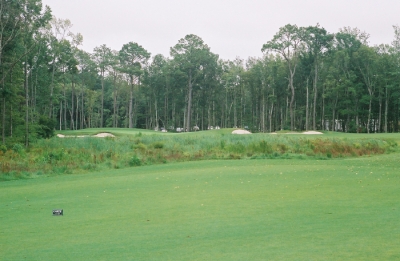 |
| Expansive wetlands provide the danger on this risk/reward par five 4th hole. |
"Tom found the property and walked it several times to see if he could design a golf course on it," said Sullivan. Steele was familiar with the developers because of their involvement in Seascape, and Sullivan knew of Steele's work at Nansemond River Golf Club, in nearby Suffolk, Virginia.
The golf course that Steele found in the woods of Currituck County is a 6,412-yard shotmaker's delight. The scenic par-72 layout offers a delightful mixture of long and short par-4s, risk/reward par-5s and par-3s that range from as little as 80 yards for the ladies to as much as 201 yards and more for tournament players.
Fairways are covered with 419 Bermudagrass (overseeded with rye in cool weather months) and the greens feature a smooth-rolling mixture of A-1 and A-4 strains of bent grass.
The opening two holes at Kilmarlic move away from the clubhouse and the next two double back. The first is a 395-yard, par-4 with a wide fairway protected on the right by a long, narrow bunker. Approaching the green, trouble appears on the right again, in the form of a pond and two bunkers sandwiched between the water and the putting surface.
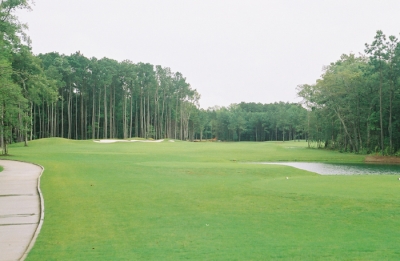 |
| Fairway bunkers provide an aiming point on the par five 9th hole. |
The picturesque second hole is the first of five par-3s at Kilmarlic. A small pond shared with the eleventh hole to the left guards the green. There's bailout room to the right for those who decline to fire directly over the hazard.
The short, drive-and-pitch third hole is followed by a terrific risk/reward par-5 hole. After placing your drive in the fairway, you have to decide whether to go for the green over wetlands that protrude into the inside of the dogleg left fairway or just hit an iron over a corner of the tall reeds and leave yourself with a pitching wedge to the putting surface.
Players will remember the 487-yard sixth hole for its prodigious length. According to Sullivan, "It's the toughest hole for the average player to make a par on. There's water on the left side and a big bunker complex near the green; it's long... It has every element that makes a hole difficult."
In contrast, the par-4 eighth tempts long hitters to drive the green. Just 279-yards from the back tees, this hole offers nearly every player the chance to make a birdie.
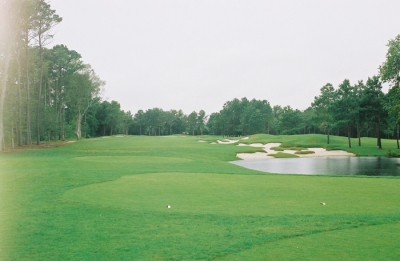 |
| Bunkers and mounds on the right extend all the way to the landing area on the par four 1st hole. |
The back nine opens with a short, dogleg-right, par-4 that is followed by a par-3 featuring an island green. Shaped like a three-leaf clover, the green offers hole locations on what are effectively peninsulas, so just aim for the center of the putting surface to be on the safe side.
The par-5 twelfth hole turns hard to the right. You have to drive over wetlands, and then contend with mounds and bunkers and swales -- oh, my -- on your way home. The par-4 fourteenth is another drive-and-pitch hole, but beware. The pond guarding the left side of the green comes into play if you're long with your approach (or skull your bunker shot from the right side of the green).
Kilmarlic's brawny finishing holes (handicap numbers 2, 6 and 4 respectively) demand your complete attention until you putt out on the eighteenth green.
"A number of things can happen here to change the complexion of a tournament or match. The par-5s are reachable, so birdie or even eagle is possible and someone who's behind can make up ground," said Sullivan.
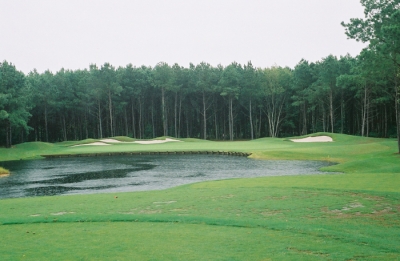 |
| The par three 5th hole features an inviting target and multiple hole locations. |
The sixteenth, a 552-yard, par-5, is similar to the fifth hole in the way that wetlands intrude into the fairway from the left, forcing a go/no-go decision for your second shot.
Wetlands on the seventeenth hole are interposed between the green and the gold and black tees. It's a 201-yard shot from the tips, and you have to stop the ball on a green that sits at an angle to the line of play. The 514-yard, par-5 eighteenth hole curves around a lake that's just waiting to swallow golf balls hit too far offline to the left.
As the new kid on the block, Kilmarlic still has some growing up to do. The temporary pro shop behind the eighteenth green will be replaced by a permanent structure now in the design phase. Styled after the Currituck hunt clubs of the past, it will house the pro shop, locker rooms, a grill, a full-service restaurant and private banquet facilities upstairs overlooking the course.
Kilmarlic's practice facilities are in place now, and they are impressive. The full size range features an expansive all-grass teeing area and pyramids of shiny new practice balls. A putting green, practice bunker and chipping area round out the offerings.
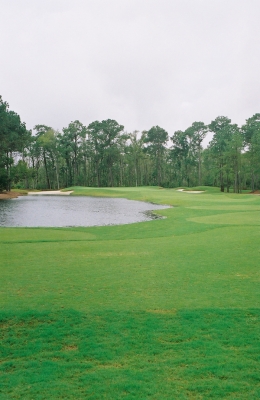 |
| Hazards abound on the par three 2nd hole. |
There are cart paths around the tee and green complexes, but not along the fairways. When asked about that Sullivan said, "Tom Steele doesn't like cart paths to be seen on the course. We're going for more of a Pinehurst feel, with pine straw paths along the edges of the fairways instead of hard surfaces."
Although there is a real estate component to Kilmarlic, it will never overshadow the golf course.
"The housing is really constrained by wetlands. Only eight or nine holes will have homes on them," Sullivan stated. "But only four or five will have homes that players might notice."
That feeling of seclusion is one of the things that makes Kilmarlic so enjoyable. In addition to the pleasant walk-in-the-park atmosphere, Kilmarlic offers a stimulating test of strategic thinking and skillful shotmaking. That's probably one of the reasons that the course has been selected to host the North Carolina Open in June 2004.
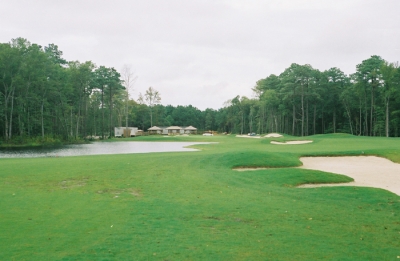 |
| A lake on the left side of the fairway protects the par five 18th hole. |
So, is Kilmarlic truly legendary? Maybe. Maybe not. But after playing it for yourself, you'll probably say it was real -- real fun.
Kilmarlic Golf Club is a member of the Outer Banks Golf Association. Golf packages with overnight accommodations can be arranged by calling 800-916-6244. Information is available at www.outerbanksgolf.com.
Details:
Kilmarlic Golf Club
P.O. Box 279
Harbinger, NC 27941
Located just off Rt. 158. Look for the big yellow Dixie BBQ sign.
Phone: (252) 384-1046
Website: www.kilmarlicgolfclub.com
Course Architect: Tom Steele
Director of Golf: Bryan Sullivan
Head Golf Professional: Dan O'Boyle
Superintendent: Bill Honeycutt
| Tees | Yardage/Slope | Rating |
| Black | 6412/133 | 72.2 |
| Gold | 5986/128 | 70.1 |
| White | 5507/116 | 68.2 |
| Red | 4688/112 | 67.8 |
Rates:
Rates vary according to season, ranging from $50 in winter to $95 in the summer season, which runs from June 16th to August 17th.
Twilight and reduced replay rates are also available.
All rates include golf cart, green fee, and range balls. Rates are subject to change without notice. Consult the website for more information.
| Related Links | Comments on this article? | |
|
Maryland National Golf Club Hollow Creek Golf Club Rocky Gap Resort PB Dye Golf Club in Ijamsville Whiskey Creek Golf Club |
E-mail Jeff Rendall, Editor: jrendall@golftheunitedstates.com |











